by Steve Cunningham
Syntrillium Software’s Cool Edit Pro has been around for more than a few years now. In fact, the last time this magazine reviewed the multitrack Cool Edit Pro product, Ms. Lewinsky and Ms. Tripp were still speaking to one another (May 1997). Since then Syntrillium have made improvements in their original Cool Edit shareware stereo editor — which became Cool Edit 2000 — and those improvements have been incorporated into version 2.0 of Cool Edit Pro, along with a host of other new features.
Cool Edit Pro 2.0 is a multitrack software editor for the PC platform that combines a full suite of recording and editing tools with 45 DSP effects, many of which work in real-time. Mixing in CEP2 takes the form of the familiar volume envelopes superimposed over the waveform. The program records up to 24-bit digital audio at sample rates up to 192kHz and higher, assuming your sound card supports those rates. And CEP2 can record and play through multiple sound cards using up to 32 simultaneous channels.
The most significant additions to version 2.0 are an increase in the track count from 64 to 128, real time EQ on every channel, and real-time effects with track bussing. Also new is a mixer window to show you where the master “channel faders” are positioned, loop creation and editing tools for those of you who like to generate your own beds from loops, and several new effects.
Cool Edit Pro’s minimum computer requirements are still modest, considering its capabilities: Windows 98, ME, 2000, or XP running on a 233 MHz processor, 64MB RAM, 55MB free hard drive space, a stereo sound card, and a CD-ROM drive. Syntrillium recommends a 700MHz processor and 128MB of RAM, and I’d suggest you have at least 256MB of RAM for best performance.
Cool Edit Pro 2.0 is still one of the only multitrack editors that will run a respectable track count on a slower PC, thanks to the program’s internal pre-mixing function. CEP2 pre-mixes all tracks that are destined for an output, internally and in the background. You probably won’t even notice this pre-mixing until your track count starts to get high, and even then it’s quick enough. It’s also one of the ways Syntrillium is able to get CEP2 to do 128 tracks on a moderate PC. Do keep in mind that you’ll need a faster CPU if you want to load up on real time effects, which burn through CPU cycles like nobody’s business.
In addition, you’ll want to have a CD burner for final output, and a large-ish monitor capable of at least 800x600 resolution. The bigger the monitor the better, since Cool Edit Pro packs a lot of information onto a single screen. You can resize any of the window’s elements to make things easier to see, but a 19" or 21" monitor with 1024x768 resolution will give you plenty of screen real estate without giving you eyestrain, especially if you’re a Fellow Old Guy.
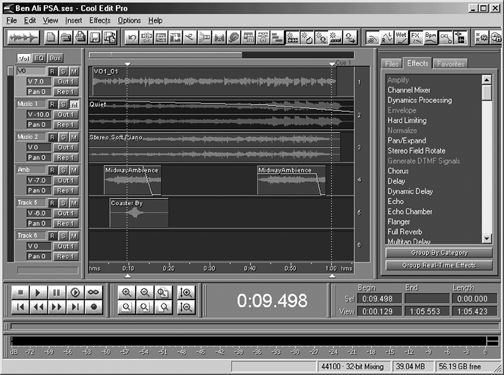
THE INTERFACE
If you’re a Cool Edit veteran, then you’ll feel right at home with Cool Edit Pro 2.0, as not a lot has changed. Most commands are still right where you left them. If you’re new to Cool Edit Pro 2.0, you’ll find it a bit like playing the piano for the first time; it’s easy to play but not easy to play well. To be really quick on CEP2, you’ll still need to memorize many of the keyboard equivalents and mouse tricks available that mimic most of the menu commands. Syntrillium offers a PDF file on their website that will show you five pages of keyboard and mouse equivalents — get it, you’ll be able to work a lot faster.
Mouse and keyboard commands are well-supported in both the Edit View (a single track) and the Multitrack View. For example, if you have a mouse with a scroll wheel (like the Intellipoint mouse), then moving the wheel forward zooms in and moving it backwards zooms out, which is very slick. Right-clicking on the Amplitude ruler in the Edit View zooms vertically.
Both the Edit and Multitrack Views can also display an Explorer-like Organizer on the left side, with three tabs that let you browse different items. The first tab is Files, where you can load and audition any CEP2 compatible audio file from your hard disks. You can then drag any of the listed files onto the time line to place it. The second tab shows you all available effects, and gives you several sorting options. The third tab in the Organizer is Favorites, where you can drag your most-used effects for quick retrieval.
This new Organizer window is a handy device for speeding up your workflow. For example, you can load a number of music beds you are considering for a spot, and audition them before actually placing them on tracks. The Favorites tab is essential if you have a large number of effects — and you will, since 45 are included with CEP2. While you can resize it, the Organizer does eat a sizeable chunk of valuable screen real estate, giving us yet another reason to use a large monitor with Cool Edit Pro 2.0.
As you might have guessed, CEP2 maintains the two-view approach of its older siblings, with a button in the upper left that switches between the Multitrack View and the single-track Edit View. Both views use the top of the screen for the customizable toolbar and the scroll bar, and the bottom of the screen for transport controls and counters.
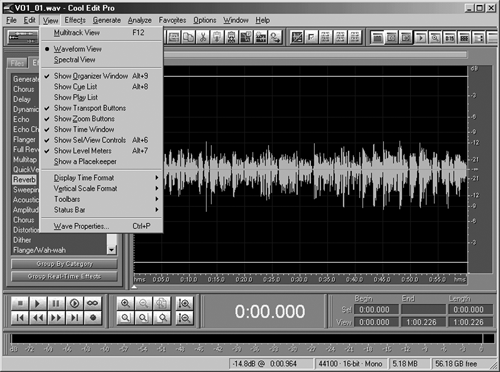
EDIT VIEW
The Edit View is the best view for surgical editing. The center shows you a single mono or stereo track in detail, and if you zoom in far enough then individual samples become draggable points that can be adjusted to fix a bad edit or eliminate a click. The menu bar gives you access to all the usual edit suspects like cut, copy, paste, trim, unlimited undo, and also lets you apply any effects to the track.
From the Edit View, CEP2 can perform batch processes to individual files by means of scripts. You can have a script that runs all your clips through a limiter set to -3dB to prepare them for CD burning, or you can run a portion of a single file through a batch that turns the sound into laser blasts. A script command allows you to simply perform a series of steps and they’ll be recorded... no programming required.
Like previous versions of Cool Edit Pro, effects applied in the Edit View are not real-time. Instead, invoking most effects presents you with a dialog box and a Preview button. You adjust the effect from within the dialog box until you like it, then press OK. CEP2 then generates a new temporary file with the effect applied and displays that waveform. You can undo the effect and get the original file back until you save. In addition, effects can only be applied individually, not in a chain. For chaining and for real-time effects, you must work in the Multitrack View.
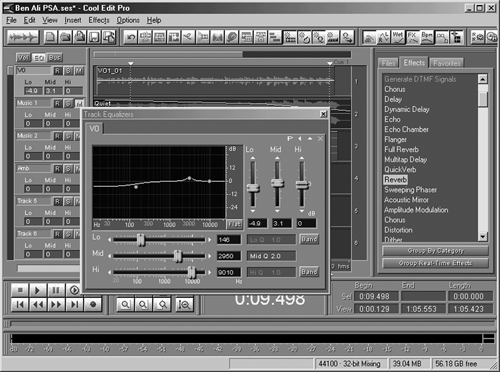
MULTITRACK VIEW
The Multitrack View looks as you would expect, with a track pane that’s bordered on the left by record/solo/mute switches, I/O assignments, and FX, volume, pan, and wet and dry sliders. Each track also has a dedicated EQ with low, mid, and high bands, with the mid band parametric and the others either shelving or parametric.
DSP effects in the Multitrack View are non-destructive, and can be inserted in series or assigned to a bus. Clicking on a track’s FX button brings up a dialog box where you select effects from a list. After you’ve populated your virtual “effects rack,” then the next time you double-click on the FX button you’ll see a window with tabs for the different effects. An additional mixer tab lets you choose whether the effects you’ve selected act in series or in parallel, and shows bypass status.
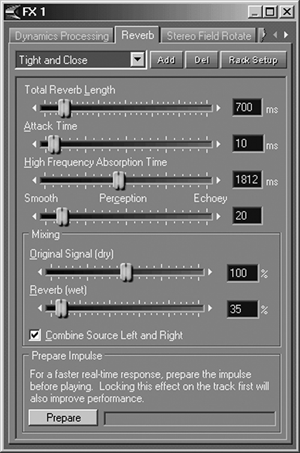 EFFECTS
EFFECTS
You can use any DirectX plug with Cool Edit Pro, although with the 45 effects included you won’t feel any pressing need to acquire more plugs. Those 45 cover all the necessary categories, and some strange ones that you “zap and whoosh” types should enjoy using.
Only four of the effects seem to be automated: Dynamic Delay, Dynamic EQ, Pan/Expand, and Stereo Field Rotate. The others have parameters that remain static throughout the track, but that wasn’t a deal-breaker for me. The quality of all the effects is above average, and several are outstanding.
In particular, Cool Edit Pro’s Noise Reduction set gets high marks for ease of use and good results. They worked wonders for me on some transfers from VHS and 1/4" reel, cleaning them up nicely with minimal artifacts. My experience with noise reduction processing is that rather than a single mondo-clean process, you’re better off making small corrections in multiple passes which was what I did with Cool Edit Pro to good effect.
LOOPOLOGY
Syntrillium has created a new website that should interest those of you who create custom music beds. Loopology.com offers over 2,000 free loops, grouped together in categories and by instruments. The loops are all stored in Syntrillium’s new .CEL (Cool Edit Loop) format, which is part of CEP2.
Of particular interest is the Music Beds category, which contained at this writing 24 complete beds, covering styles from techno and rock to bossa nova. You can download any of these and import them directly into Cool Edit Pro, where you can adjust their tempo, pitch, or both just as you might in Acid.
I found some loops featuring a swing-style acoustic bass and brushes that gave me a low-key, hip-sounding bed for a bank spot. The loops are of good quality, and the tempo-changing feature worked as advertised. CEP2’s looping functions are not quite as comprehensive as Acid, but they worked well and the loops are free. Nice touch, and I hope they continue to expand the collection on loopology.com.
RED ROVER COMES OVER
Syntrillium also sent me the optional Red Rover controller for use in this review. Red Rover is a small USB device that serves as rudimentary transport controls for Cool Edit Pro. In addition to the customary Record, Play, Stop, FF, and Rewind buttons along the bottom of the unit, Red Rover has a backlit 2 line by 20 character LCD display. The top line of the display indicates the transport status, the time, and the current track’s input device, while the bottom line shows the master volume, and the current track’s volume, number, and output device. Three knobs located just below the display let you adjust these last parameters in real time.
In addition, there are smaller buttons for Mute, Solo, and Record, as well as a button to turn the metronome on and off, and one labeled Add Cue that drops a marker in real time, even when the track is playing. Rounding out the Red Rover is an LED level meter that indicates volume for the current track, backlight on/off and contrast controls on the side of the unit, and a footswitch jack for hands-free punching.
At $129, the Red Rover controller is one of the least expensive transport controllers out there. It gives you the functions you need to record up to ten feet away from the computer, but provides little help in the editing process. So while it works for tracking in a one-man-band environment, it will not replace the mouse and keyboard for editing. It is well-integrated into Cool Edit Pro, and having the track select on a continuous knob rather than in a bank-select arrangement is slick. However, it appears that it does not recognize editors other than Cool Edit Pro, so don’t expect to use it with Forge.
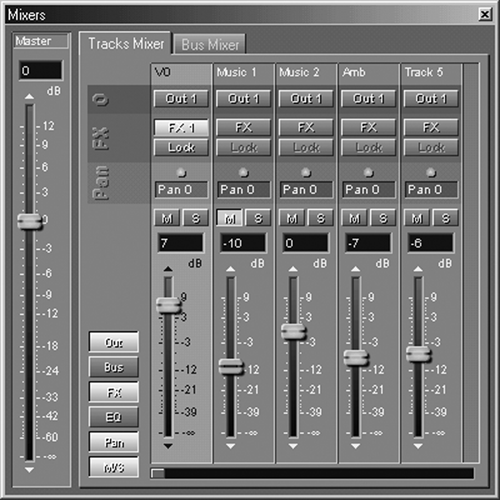
DO YA LIKE IT?
Sure, why not? The program is stable and mature, and although I did see a couple of menu anomalies during my work with it, it never crashed. The editing functions are complete, and with the addition of real time effects I was able to build fully-produced spots quickly.
While I have some quibbles with the amount of information and minutia on the screen, you can chalk some of that up to my 17" monitor and my less-than-youthful eyesight. Nothing that a 21" screen and Lasik wouldn’t cure. I’d also like to have more than the stereo metering supplied. It has good resolution, but I missed being able to see meters for all tracks at a glance.
While the program is initially pretty easy to get around on, getting some serious speed and productivity on it requires memorizing a lot of those keyboard and mouse equivalents and special moves. But I’ve had several discussions with production-types who use the program daily, and they all tell me that they’re faster on Cool Edit Pro than on any other editor bar none.
Is it worth the upgrade price? Absolutely, if only for the real-time effects and increased track count. Cool Edit Pro 2.0 represents a serious step forward in capabilities. For as little as $79 for the upgrade from version 1, you get a lot more oomph from a program that more than holds its own against Vegas and SAW. Cheap, fast, complete, easy on the CPU... yeah, it’s worth it.
Cool Edit Pro 2.0 is available as a fully-functional 21 day demo from Syntrillium Software’s website (www.syntrillium.com). A download-only version of Cool Edit Pro 2.0 is $249, while a boxed version with CD and manual costs $279. Upgrades from Cool Edit Pro 1.x are $79 download, boxed $109, and upgrades from Cool Edit 2000 are $199 download, and $229 boxed. For more information in the US, call Syntrillium at (888) 941-7100. For more information worldwide visit www.syntrillium.com (recommended) or email

